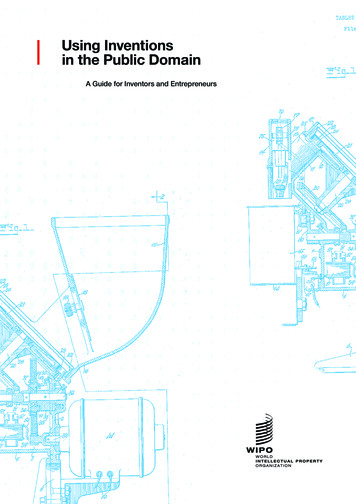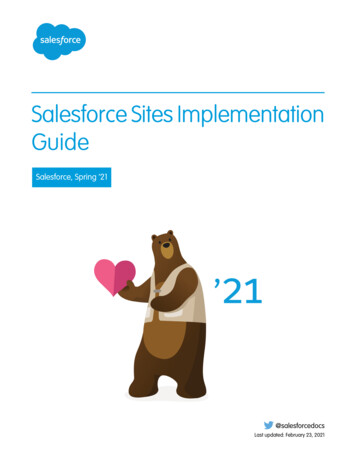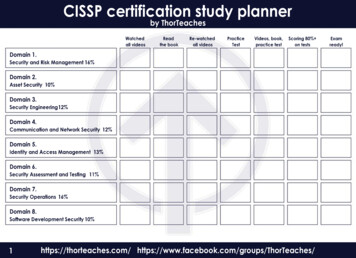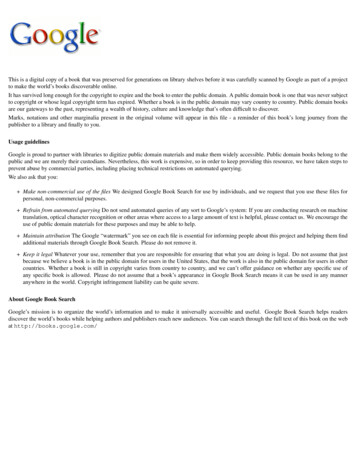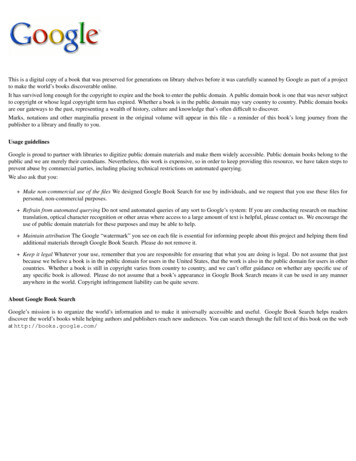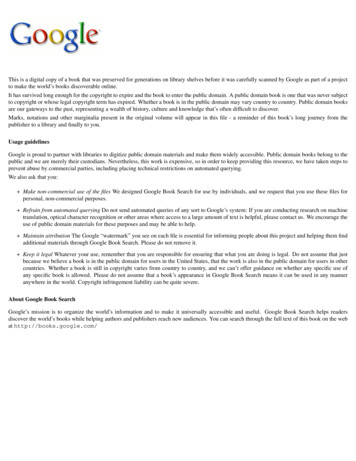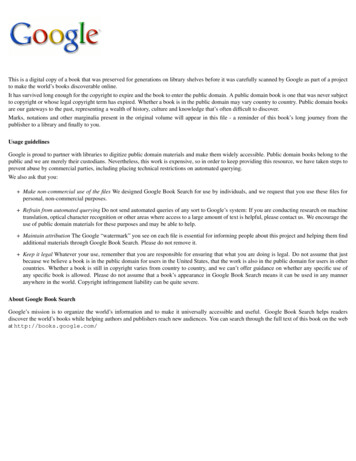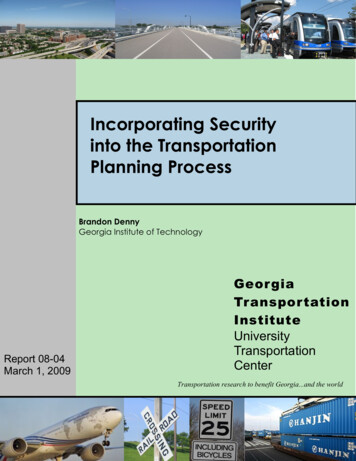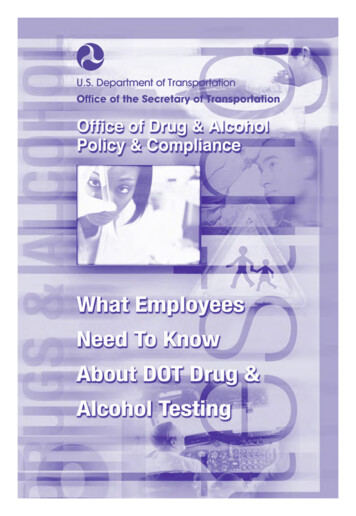
Transcription
DisclaimerThis publication was produced by the U.S. Department of Transportation (DOT)to assist safety-sensitive employees subject to workplace drug & alcohol testingin understanding the requirements of 49 CFR Part 40 and certain DOT agencyregulations. Nothing in this publication is intended to supplement, alter or serveas an official interpretation of 49 CFR Part 40 or DOT agency regulations. Thispublication is for educational purposes only.Public Domain NoticeAll material in this publication is in the public domain and may be reproducedwithout permission from ODAPC, although attribution is appreciated. However,this guide may not be reproduced or distributed for a fee without specific writtenauthorization of ODAPC.Electronic Access to PublicationThis publication can also be accessed electronically through the internet atwww.dot.gov/odapc.For questions, please contact DOT’s Office of Drug & Alcohol Policy & Complianceat 202-366-DRUG (3784) or visit our website at www.dot.gov/odapc.Originating OfficeU.S. Department of TransportationOffice of the SecretaryOffice of Drug & Alcohol Policy & Compliance1200 New Jersey Avenue, SERoom W62-300Washington, DC 20590202.366.DRUG (3784)202.366.3897 faxodapcwebmail@dot.govwww.dot.gov/odapc
What Employees NeedTo Know AboutDOT Drug & Alcohol TestingU.S. Department of Transportation (DOT)Office of the Secretary (OST)Office of Drug & Alcohol Policy & Compliance (ODAPC)
Table of ContentsvIntroduction: “Why is this program so important?”Ray LaHoodSecretary of TransportationU.S. Department of Transportation1What Employees Need To Know About DOT Drug & Alcohol Testing1221212121313131415Who is subject to DOT testing?Why are safety-sensitive employees tested?What information must employers provide when I first begin performingDOT safety-sensiitive functions?What conduct is prohibited by the regulations?What drugs does DOT test for?Can I use prescribed medications & over-the-counter (OTC) drugs andperform safety-sensitive functions?When will I be tested?Pre-EmploymentReasonable llow-UpHow is a urine drug test administered?The CollectionTesting at the LaboratoryReview by the Medical Review Officer (MRO)What are Medical Review Officers (MRO)?How is an alcohol test administered?Should I refuse a test if I believe I was unfairly selected for testing?What is considered a refusal to test?What happens if I test positive, refuse a test, or violate an agency specificdrug & alcohol rule?What are SAPs?How do I find a SAP?Will I lose my job if I violate drug & alcohol regulations?Will my results be confidential?Will the results follow me to different employers?What should I do if I have a drug or alcohol abuse problem?Did you know?But, I have more questions?15Appendix: Drug & Alcohol Program Manager Contact Information2334455555778899101111iv1-11886 DrugAlcoholTesting.indd 4W h a t E m p l o y E E s N E E d t o K N o W a b o u t dot d r u g & a l c o h o l t E s t i N g12/16/11 1:46 PM
U.S. Department of TransportationOffice of the Secretary“Why is this program so important?”Safety is our no. 1 priority at the U.S.Department of Transportation.And acornerstone of our safety policy is ensuringthat transportation providers across all modes– on roads, rails, water, or in the air, overland and underground – employ operatorswho are 100 percent drug- and alcohol-free.We want – and we insist upon – safetyconscious employees at all times and under allcircumstances.Fortunately, the transportation industry over time has worked hard toreduce the number of accidents and crashes directly related to drugand alcohol use. Nevertheless, human risk factors remain – and sometransportation workers do use illicit drugs, or abuse alcohol, despiteserious efforts to deter them.We must never stop trying to improve our safety record where substanceabuse is concerned. We can start by making sure that employees areproperly educated on the personal and professional consequences ofdrug use and alcohol misuse. Supervisors must be appropriately trainedto identify signs and symptoms of drug and alcohol use.Employers must also have strong drug and alcohol testing programs. Andemployees must be removed from safety-sensitive duties immediatelyafter they violate drug and alcohol testing rules. It is very importantthat employees are not returned to safety-sensitive duty until they arereferred for evaluation and have successfully complied with treatmentrecommendations.I know you will support these important measures, so that we can assurethe traveling public that our transportation system is the safest it canpossibly be.Ray LaHoodSecretary of TransportationU.S. Department of TransportationJuly 2009Office of Drug and Alcohol Policy and Complianceu.s. dEpartmENtoftraNsportatioNv
This page intentionally left blank.
What Employees Need To Know About DOT Drug & Alcohol TestingJust entering the transportation industry? Performing tasks defined by the USDepartment of Transportation (DOT) as safety-sensitive, such as working onpipelines, driving a truck, operating a ferry or a train, or repairing an airplane?Then, you are subject to DOT workplace drug & alcohol testing. Here are thebasics you need to know about DOT’s program.Who is subject to DOT testing?Anyone designated in DOT regulations as a safety-sensitive employee is subjectto DOT drug & alcohol testing. What follows is an overview of what jobs aredefined as safety-sensitive functions subject to testing.AviationFlight crews, flight attendants, flight instructors, air traffic controllersat facilities not operated by the FAA or under contract to the U.S.military, aircraft dispatchers, aircraft maintenance or preventativemaintenance personnel, ground security coordinators and aviationscreeners. Direct or contract employees of 14 CFR Part 121 or 135certificate holders, Section 91.147 operators and air traffic controlfacilities not operated by the FAA or under contract to the US Military.See FAA regulations at 14 CFR Part 120.CommercialMotorCarriersCommercial Drivers License (CDL) holders who operate CommercialMotor Vehicles, 26,001 lbs. gvwr. or greater, or operate a vehiclethat carries 16 passengers or more including the driver, or required todisplay a DOT placard in the transportation of hazardous material.1 SeeFMCSA regulation at 49 CFR Part 382.MaritimeCrewmembers operating a commercial vessel.See USCG regulations at 46 CFR Parts 4 & 16.PipelineOperations, maintenance and emergency response.See PHMSA regulations at 49 CFR Part 199.RailroadHours of Service Act personnel, engine & train, signal service ortrain dispatchers. See FRA regulations at 49 CFR Part 219.TransitVehicle operators, controllers, mechanics and armed security.See FTA regulations at 49 CFR Part 655.FAAFMCSAUSCG2PHMSAFRAFTALinks to these regulations can be found on-line at www.dot.gov/odapc.Remember: The tasks you actually perform qualify you as a safety-sensitiveemployee, not your job title. Also, some employees, like managers andsupervisors, may be qualified for these jobs but not currently performing them.Do they have to be tested as well? In most cases, yes if that employeemay be asked at a moment’s notice or in an emergency to perform a safetysensitive job. Be sure to check industry specific regulations for furtherclarification.12In some instances, states allow waivers from this qualification, such as operators of fire trucks and somefarm equipment. Check with your state department of motor vehicles for more information.An agency of the U.S. Department of Homeland Security.u.s. dEpartmENt1-11886 DrugAlcoholTesting.indd 1oftraNsportatioN112/16/11 1:46 PM
Why are safety-sensitive employees tested?The short answer is for the safety of the traveling public, co-workers and yourself.The longer answer is that the United States Congress recognized the need fora drug & alcohol free transportation industry, and in 1991 passed the OmnibusTransportation Employee Testing Act, requiring DOT Agencies to implement drug &alcohol testing of safety-sensitive transportation employees.3Within DOT, the Office of the Secretary’s Office of Drug & Alcohol Policy &Compliance (ODAPC) publishes rules on how to conduct those tests, whatprocedures to use when testing and how to return an employee to safety-sensitiveduties. Encompassed in 49 Code of Federal Regulations (CFR) Part 40, ODAPCpublishes and provides authoritative interpretations of these rules.DOT agencies and the U.S. Coast Guard write industry specific regulations, spellingout who is subject to testing, when and in what situations. Industry employersimplement the regulations that apply to them.The benefit to all employees affected by DOT regulations is that each agency’sregulations must adhere to DOT’s testing procedures found at 49 CFR Part 40,commonly known as “Part 40.” For example, you may work in the rail industry andlater work in the motor carrier industry, but the procedures for collecting, testingand reporting of your tests will be the same under Part 40.What information must employers provide when I first beginperforming DOT safety-sensitive functions?Depending on the DOT agency over-seeing your industry, your employer may berequired to provide you with educational materials and a company policy that explainthe requirements of DOT’s drug & alcohol testing regulations and the proceduresto help you comply. If you have not received this information, be sure to ask youremployer about it.What conduct is prohibited by the regulations?As a safety-sensitive employee You must not use or possess alcohol or any illicit drug while assigned to performsafety-sensitive functions or actually performing safety-sensitive functions. You must not report for service, or remain on duty if you - Are under the influence or impaired by alcohol;- Have a blood alcohol concentration .04 or greater; (with a blood alcoholconcentration of .02 to .039, some regulations do not permit you to continueworking until your next regularly scheduled duty period);- Have used any illicit drug. You must not use alcohol within four hours (8 hours for flight crew members andflight attendants) of reporting for service or after receiving notice to report.3The Omnibus Act’s testing requirements do not apply to PHMSA.21-11886 DrugAlcoholTesting.indd 2W h a t E m p l o y E E s N E E d t o K N o W a b o u t dot d r u g & a l c o h o l t E s t i N g12/16/11 1:46 PM
You must not report for duty or remain on duty when using any controlledsubstance unless used pursuant to the instructions of an authorized medicalpractitioner. You must not refuse to submit to any test for alcohol or controlled substances. You must not refuse to submit to any test by adulterating or substituting yourspecimen.Keep these in mind when preparing to report to work.What drugs does DOT test for?DOT drug tests are conducted only using urine specimens. The urine specimensare analyzed for the following drugs/metabolites: Marijuana metabolites/THC Cocaine metabolites Amphetamines(including methamphetamine, MDMA) Opiates(including codeine, heroin (6-AM), morphine) Phencyclidine (PCP)Specimens Collected forDrug & Alcohol Testing*Drugs:Alcohol:UrineBreath & Saliva* The FRA requires blood specimens aspart of their Post-Accident testing.To learn more about the effects of these and other drugs visit the following sites: Drugs and Human Performance Fact Sheet. National Highway Traffic SafetyAdministration (NHTSA) www.nhtsa.dot.gov. Driving While You Are Taking Medications. National Highway Traffic SafetyAdministration (NHTSA) www.nhtsa.dot.gov. Common Drugs of Abuse. National Institute for Drug Abuse (NIDA)www.nida.nih.gov. Substance Abuse. Substance Abuse and Mental Health Administration (SAMHSA)www.workplace.samhsa.gov. Drug Facts. Office of National Drug Policy Control (ONDCP)www.whitehousedrugpolicy.gov. Prevention On-line. National Clearinghouse for Alcohol and Drug Information(NCADI) www.health.org.Can I use prescribed medications & over-the-counter (OTC) drugsand perform safety-sensitive functions?Prescription medicine and OTC drugs may be allowed.4 However, you must meetthe following minimum standards: The medicine is prescribed to you by a licensed physician, such as your personaldoctor.4The FRA requires that if you are being treated by more than one medical practitioner, you must show that atleast one of the treating medical practitioners has been informed of all prescribed and authorized medicationsand has determined that the use of the medications is consistent with the safe performance of your duties.u.s. dEpartmENtoftraNsportatioN3
The treating/prescribing physician has made a good faith judgment that the use ofthe substance at the prescribed or authorized dosage level is consistent with thesafe performance of your duties.Best Practice: To assist your doctor in prescribing the best possible treatment,consider providing your physician with a detailed description of your job. Atitle alone may not be sufficient. Many employers give employees a written,detailed description of their job functions to provide their doctors at the time ofthe exam. The substance is used at the dosage prescribed or authorized.5 If you are being treated by more than one physician, you must show that at leastone of the treating doctors has been informed of all prescribed and authorizedmedications and has determined that the use of the medications is consistentwith the safe performance of your duties. Taking the prescription medication and performing your DOT safety-sensitivefunctions is not prohibited by agency drug & alcohol regulations. However,other DOT agency regulations may have prohibitive provisions, such as medicalcertifications.Remember: Some agencies have regulations prohibiting use of specificprescription drugs, e.g. methadone, etc . If you are using prescription orover-the-counter medication, check first with a physician, but do not forget toconsult your industry-specific regulations before deciding to perform safetysensitive tasks. Also be sure to refer to your company’s policy regardingprescription drugs.When will I be tested?Safety-sensitive employees are subject to drug or alcohol testing in the followingsituations: Pre-employment.Reasonable st-Accident.Pre-EmploymentAs a new hire, you are required to submit to a drug test. Employers may, butare not required to, conduct alcohol testing.6 Only after your employer receives anegative drug test result (and negative alcohol test result - if administered) may youbegin performing safety-sensitive functions. This also applies if you are a currentemployee transferring from a non-safety-sensitive function into a safety-sensitiveposition (even if it is the same employer).While a minority of states allow medical use of marijuana, federal laws and policy do not recognize anylegitimate medical use of marijuana. Even if marijuana is legally prescribed in a state, DOT regulations treat itsuse as the same as the use of any other illicit drug.6Not every DOT agency requires a pre-employment alcohol test.54W h a t E m p l o y E E s N E E d t o K N o W a b o u t dot d r u g & a l c o h o l t E s t i N g
Reasonable Suspicion/CauseYou are required to submit to any test (whether drug, alcohol or both) that asupervisor requests based on reasonable suspicion. Reasonable suspicion meansthat one or more trained supervisors reasonably believes or suspects that you areunder the influence of drugs or alcohol. They cannot require testing based on ahunch or guess alone; their suspicion must be based on observations concerningyour appearance, behavior, speech and smell that are usually associated with drugor alcohol use.RandomYou are subject to unannounced random drug & alcohol testing. Alcohol testing isadministered just prior to, during or just after performing safety-sensitive functions.Depending on the industry specific regulations, you may only be subject to randomdrug testing.7No manager, supervisor, official or agent may select you for testing just becausethey want to. Under DOT regulations, employers must use a truly random selectionprocess. Each employee must have an equal chance to be selected and tested.Just prior to the testing event, you will be notified of your selection and providedenough time to stop performing your safety-sensitive function and report to thetesting location. Failure to show for a test or interfering with the testing process canbe considered a refusal.Post-AccidentIf you are involved in an event (accident, crash, etc.) meeting certain criteria of theDOT agency, a post-accident test will be required. You will then have to take a drugtest and an alcohol test.8 You are required to remain available for this testing and arenot permitted to refuse testing.Remember: Safety-sensitive employees are obligated by law to submit to andcooperate in drug & alcohol testing mandated by DOT regulations.Return-to-DutyIf you have violated the prohibited drug & alcohol rules, you are required to take adrug and/or alcohol test before returning to safety-sensitive functions for any DOTregulated employer. You are subject to unannounced follow-up testing at least 6times in the first 12 months following your return to active safety-sensitive service.Return-to-duty tests must be conducted under direct observation.Follow-upThe amount of follow-up testing you receive is determined by a Substance AbuseProfessional (SAP) and may continue for up to 5 years. This means the SAP willdetermine how many times you will be tested (at least 6 times in the first year), forhow long, and for what substance (i.e. drugs, alcohol, or both). Your employer isresponsible for ensuring that follow-up testing is conducted and completed. Followup testing is in addition to all other DOT required testing. All follow-up tests will beobserved.78USCG & PHMSA do not perform random alcohol tests.In post-accident testing, the FRA requires a blood specimen for drug testing.u.s. dEpartmENtoftraNsportatioN5
Overview of DOT Drug Testing4. Urine Collection3. You reportimmediately tothe collection site. Verify ID. Empty Pockets. Select Sealed Kit. Provide 45 ml of urine. Watch collector check temp and pour into 2bottles. Watch collector seal bottles A & B. Sign paperwork.5. Lab Testing Analyzes bottle A. Results sent to MedicalReview Officer (MRO).1. NotificationYou arenotifiedto submitfor a drug test.2. Why Pre-employmentReasonable SuspicionRandomPost-AccidentReturn-to-duty & Follow-up6. Medical Review7. Employees’ RightsUpon notice by the MRO,you have 72 hours fromthe MRO interview torequest the B Bottle betested by another certi fied lab.8. Verified ResultsAs gate-keeper to the integrityof the drug testing process,the MRO reviews lab resultsand determines if there areany legitimate medical reasonsfor a positive, adulterated orsubstituted result. This includesan interview with you, review ofyour medical records or a requestthat you be examined by MROapproved physician.MRO verifies results toemployer as either: Negative Positive Refusal Cancelled6W h a t E m p l o y E E s N E E d t o K N o W a b o u t dot d r u g & a l c o h o l t E s t i N g
How is a urine drug test administered?Regardless of the DOT agency requiring the drug test, the drug testing processalways consists of three components: The Collection. (49 CFR Part 40, Subparts C, D, E) Testing at the Laboratory. (49 CFR Part 40, Subpart F) Review by the Medical Review Officer. (49 CFR Part 40, Subpart G)What follows is a summary of the procedures for each step. For a more detailedaccount, please visit 49 CFR Part 40, which can be found in its entirety atwww.dot.gov/odapc.The CollectionDuring the collection process, a urine specimen collector will: Verify your identity using a current valid photo ID, such as driver’s license,passport, employer issued picture ID, etc. Create a secure collection site by:- Restricting access to the site to only those being tested.- Securing all water sources and placing blue dye in any standing water.- Removing or securing all cleaning products/fluids at the collection site. Afford you privacy to provide a urine specimen.- Exceptions to the rule generally surround issues of attempted adulteration orsubstitution of a specimen or any situation where general questions of validityarise, like an unusual temperature. Ask you to remove any unnecessary garments and empty your pockets (you mayretain your wallet). Instruct you to wash and dry your hands. Select or have you select a sealed collection kit and open it in your presence. Request you to provide a specimen (a minimum of 45 mL) of your urine into acollection container. Check the temperature and color of the urine. In your presence, pour the urine into two separate bottles (A or primary and Bor split), seal them with tamper-evident tape, and then ask you to sign the sealsafter they have been placed on the bottles.Remember: Neither you nor the collector should let the specimen out of yoursight until it has been poured into two separate bottles and sealed. Ask you to provide your name, date of birth, and daytime and evening phonenumbers on the Medical Review Officer Copy (Copy #2) of the Federal DrugTesting Custody and Control Form (CCF).- This is so the Medical Review Officer (MRO) can contact you directly if thereare any questions about your test. Complete necessary documentation on the Test Facility (Copy #1) of the CCF todemonstrate the chain of custody (i.e. handling) of the specimen. Give you the Employee Copy (Copy # 5) of the CCF and may suggest you list anyprescription and over-the-counter medications you may be taking on the back ofyour copy of the CCF (this may serve as a reminder for you in the event the MROcalls you to discuss your test results). Package and ship both sealed bottles and completed CCF to a U.S. Health andHuman Services (HHS) certified testing laboratory as quickly as possible.u.s. dEpartmENt1-11886 DrugAlcoholTesting.indd 7oftraNsportatioN712/16/11 1:48 PM
If you are unable to provide 45 mL of urine on the first attempt, the time will benoted, and you will be: Required to remain in the testing area under the supervision of the collection sitepersonnel, their supervisor, or a representative from your company,- Leaving the testing area without authorization may be considered a refusal totest Urged to drink up to 40 oz. of fluid, distributed reasonably over a period of up tothree hours, Asked to provide a new specimen (into a new collection container). If you do not provide a sufficient specimen within three hours, you must obtain amedical evaluation9 within five days to determine if there is an acceptable medicalreason for not being able to provide a specimen. If it is determined that there isno legitimate physiological or pre-existing psychological reason for not providing aurine specimen, it will be considered a refusal to test.How do you know if you are taking a federal ora private company drug test?All DOT drug tests are completed using the Federal DrugTesting Custody and Control Form. Those words appearat the top of each form.Testing at the LaboratoryAt the laboratory, the staff will: Determine if flaws exist. If flaws exist, the specimen is rejected for testing. Open only the A bottle and conduct a screening test. Specimens that screenpositive will be analyzed again using a completely different testing methodology.- If the specimen tests negative in either test, the result will be reported as anegative.- Only if the specimen tests positive under both methods will the specimen bereported to the medical review officer as a positive test. Report the findings of the analysis of the A bottle to the Medical Review Officer(MRO). Store the A and B bottles for any reported positive, adulterated, or substitutedresult for at least 12 months.Remember: The Lab will conduct specimen validity tests (SVTs) to determineif the specimen was adulterated or substituted. Tests found to be adulteratedor substituted are also reported to the MRO and may be considered a refusalto test.Review by the Medical Review Officer (MRO)Upon receipt of the test result from the laboratory, the MRO will: Review paperwork for accuracy. Report a negative result to the Designated Employer Representative (DER). If the result is positive, conduct an interview with you to determine if thereis a legitimate medical reason for the result. If a legitimate medical reason is9The physical exam is scheduled after the designated employer representative consults with the medicalreview officer. The physician chosen to complete the evaluation must have expertise in the medical issuesraised and be acceptable to the Medical Review Officer.81-11886 DrugAlcoholTesting.indd 8W h a t E m p l o y E E s N E E d t o K N o W a b o u t dot d r u g & a l c o h o l t E s t i N g12/16/11 1:48 PM
established, the MRO will report the result to the DER as negative. If not, theMRO will report the result to the DER as positive. If the result is an adulterated or substituted test, conduct an interview with youto determine if there is a legitimate medical reason for the result. If a legitimatemedical reason is established, the MRO will report the result to the DER ascancelled. If not, the MRO will report the result to the DER as a refusal. Report a non-negative test result to the DER if:- You refused to discuss the results with the MRO;- You did not provide the MRO with acceptable medical documentation toexplain the non-negative test result. Inform you that you have 72 hours from the time of the verified result to requestto have your B “split” bottle sent to another certified lab for analysis for the samesubstance or condition that was found in the A “primary” bottle.What are Medical Review Officers (MRO)?Under DOT regulations, MROs are licensed physicians with knowledge and clinicalexperience in substance abuse disorders. They must also complete qualificationtraining courses and fulfill obligations for continuing education courses. They serveas independent, impartial gatekeepers to the accuracy and integrity of the DOT drugtesting program. All laboratory results are sent to an MRO for verification before acompany is informed of the result. As a safeguard to quality and accuracy, the MROreviews each test and rules out any other legitimate medical explanation beforeverifying the results as positive, adulterated or substituted.How is an alcohol test administered?The DOT performs alcohol testingin a manner to ensure the validityof the testing as well as provideconfidentiality of the employee’stesting information.How do you know if you aretaking a federal or a privatecompany alcohol test?All DOT alcohol tests aredocumented with a form withthe words Department ofTransportation at the top.At the start of the test, a Screening Test Technician (STT) or a Breath AlcoholTechnician (BAT), using only a DOT-approved device, will: Establish a private testing area to prevent unauthorized people from hearing orseeing your test result. Require you to sign Step #2 of the Alcohol Testing Form (ATF). Perform a screening test and show you the test result. If the screening test resultis an alcohol concentration of less than 0.02, no further testing is authorized, andthere is no DOT action to be taken. The technician will document the result onthe ATF, provide you a copy and provide your employer a copy.If the screening test result is 0.02 or greater, you will be required to take aconfirmation test, which can only be administered by a BAT using an EvidentialBreath Testing (EBT) device. The BAT will: Wait at least 15 minutes, but not more than 30 minutes, before conductingthe confirmation test. During that time, you are not to be allowed to eat, drink,smoke, belch, put anything in your mouth or leave the testing area.u.s. dEpartmENt1-11886 DrugAlcoholTesting.indd 9oftraNsportatioN912/16/11 1:48 PM
Remember: Leaving the testing area without authorization may be considereda refusal to test. Perform an “air blank” (which must read 0.00) on the EBT device to ensure thatthere is no residual alcohol in the EBT or in the air around it. Perform a confirmation test using a new mouthpiece. Display the test result to you on the EBT and on the printout from the EBT. Document the confirmation test result on the ATF, provide you a copy andprovide your employer a copy. Report any result of 0.02 or greater immediately to the employer.If after several attempts you are unable to provide an adequate amount of breath,the testing will be stopped. You will be instructed to take a medical evaluation todetermine if there is an acceptable medical reason for not providing a sample. If it isdetermined that there is no legitimate physiological or psychological reason, the testwill be treated as a refusal to test.Confirmation test results are the final outcome of the test.ResultActionLess than 0.02No action required under 49 CFR Part 40.0.02 - 0.039Varies among DOT agencies. For example, FMCSA requiresthat you not resume safety-sensitive functions for 24 hours[382.505], while the FRA requires 8 hours [219.101(a)(4)].The FTA & PHMSA require only that you test below 0.02 orcannot work until the next scheduled duty period but not lessthan 8 hours from the time of the test [655.35 & 199.237respectively]. And, the FAA requires only that you test below0.02, if the employer wants to put you back to work within 8hours [14 CFR Part 120, Subpart F, 120.217(g)]. Also, be sureto check other agency specific regulations for their restrictions.0.04 or greaterImmediate removal from safety-sensitive functions.You may not resume safety-sensitive functions untilyou successfully complete the return-to-duty process.Should I refuse a test if I believe I was unfairly selected for testing?Rule of Thumb: Comply then make a timely complaint.If you are instructed to submit to a DOT drug or alcohol test and you don’
drug use and alcohol misuse. Supervisors must be appropriately trained to identify signs and symptoms of drug and alcohol use. Employers must also have strong drug and alcohol testing programs. And employees must be removed from safety-sensitive duties immediately after they violate drug and alcohol testing rules. It is very important
